20 Most Common Types of Butterflies in Tennessee (with Pictures)
-
- Last updated:

Although there are well over 100 different types of butterflies in Tennessee, this list highlights the most common and unique butterfly species that you can easily spot while you’re in the state.
These different butterflies come in all sizes, shapes, and colors, and you can even see a few during the winter months! Just keep reading as we break down 20 butterflies that you can find in the Volunteer State.

The 20 Most Common Types of Butterflies in Tennessee
1. Appalachian Tiger Swallowtail

| Scientific name: | Papilio appalachiensis |
| Size: | 3.5 to 4.5 inches |
| Primary colors: | Yellow and black |
The Appalachian Tiger Swallowtail is one of the most impressive-looking butterflies out there, and the fact that you can find them in Tennessee is a real treat. Not only do they have awesome black and yellow coloring that beautifully contrasts, but they can also have a wingspan of 4.5 inches!
While you can find these butterflies throughout the state, they’re most common in the Appalachian Mountains.
2. Red Admiral
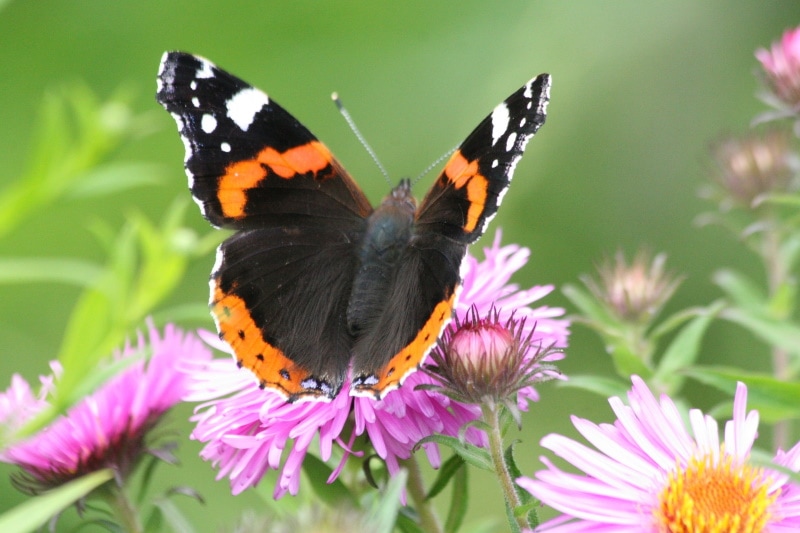
| Scientific name: | Vanessa atalanta |
| Size: | 1.75 to 3 inches |
| Primary colors: | Black and orange |
The Red Admiral is a butterfly that you can find throughout the continental United States, and Tennessee is no exception. They’re not always the largest butterflies out there, but with the bright orange coloring contrasting with the black in their body, they’re quite striking.
They get their name because the orange stripes on their body can darken to an orange/red color, but they’re typically more orange than red.
3. Diana Fritillary
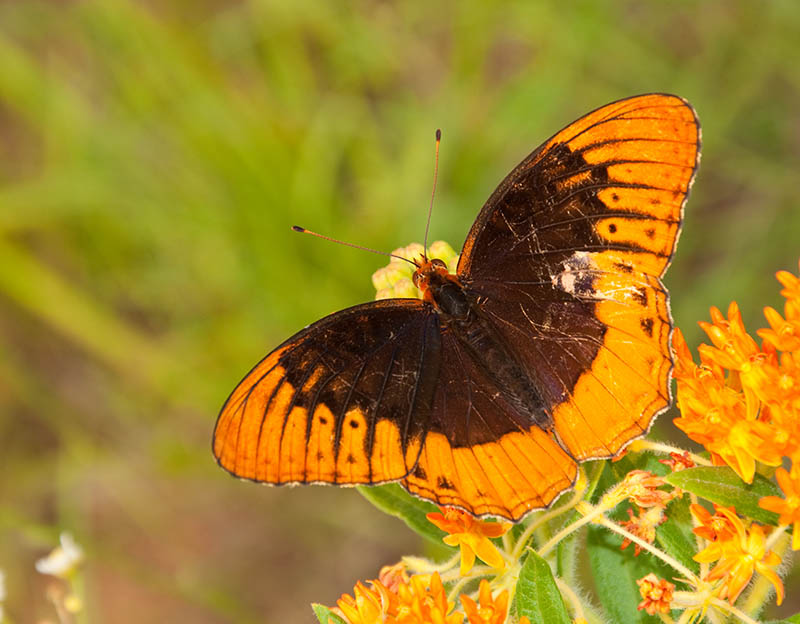
| Scientific name: | Speyeria diana |
| Size: | 3.5 to 4.5 inches |
| Primary colors: | Black and blue or black and orange |
The Diana Fritillary is a massive butterfly that you can find throughout Tennessee. That said, they’re most common on the eastern side of the state.
Males and females have distinct markings. Males have a black body with orange around the edges of their wings, while females have the same makeup but the orange spots are blue instead.
4. Painted Lady
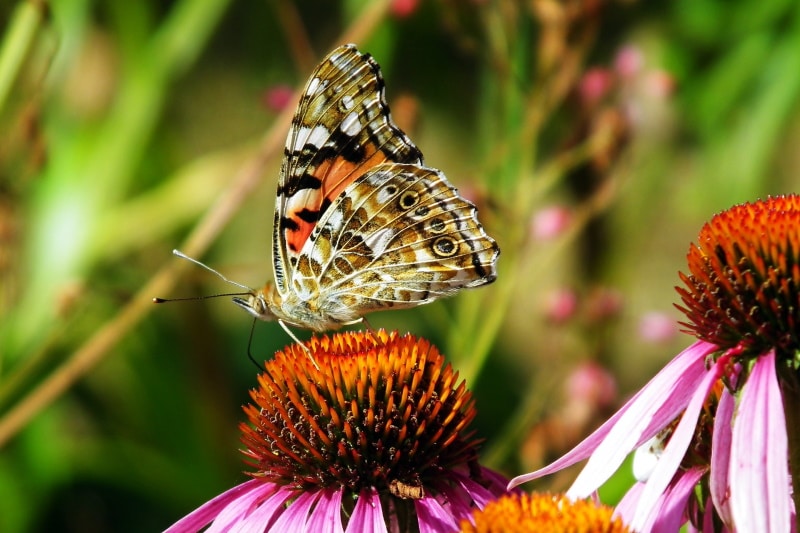
| Scientific name: | Vanessa cardui |
| Size: | 2 to 2.5 inches |
| Primary colors: | Orange and black |
Painted Lady butterflies are a small butterfly species, but with bright orange and black throughout their body, they’re a joy to watch. They migrate to Mexico over the winter, so during the right season, you can see these beautiful butterflies flying throughout the entire state.
5. Mourning Cloak
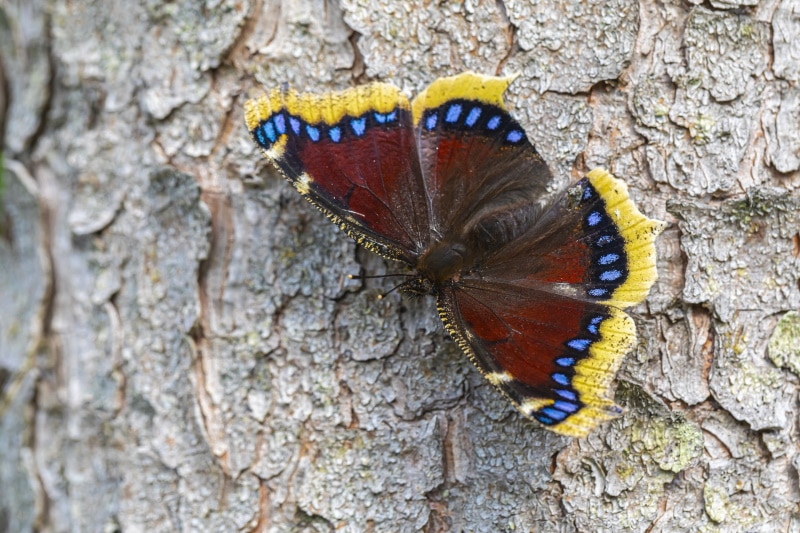
| Scientific name: | Nymphalis antipoa |
| Size: | 3 to 3.5 inches |
| Primary colors: | Red and yellow |
While most butterflies only live for a few weeks to a month, the mourning cloak butterfly is unique in that it lives for a full 10 months. That means there are plenty of opportunities to see this butterfly out and about.
They’re not the most colorful butterfly, and they’re not as common in Tennessee as they are on the western side of the United States. But you can typically find them along the state’s eastern side.
6. Monarch
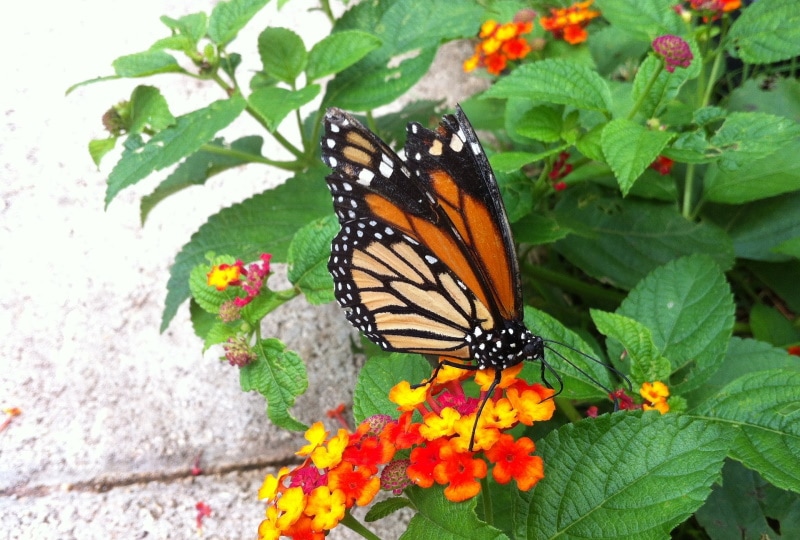
| Scientific name: | Danaus plexippus |
| Size: | 3 to 4 inches |
| Primary colors: | Orange and black |
There’s not a butterfly out there as well-known as the monarch butterfly. You can find them throughout Tennessee just as often as the rest of the country, but since they’re endangered, there aren’t solid populations of them anywhere.
The monarch butterfly is a large, stunning butterfly with orange and black coloring, so if you see one, you’re bound to notice.
7. Cabbage White
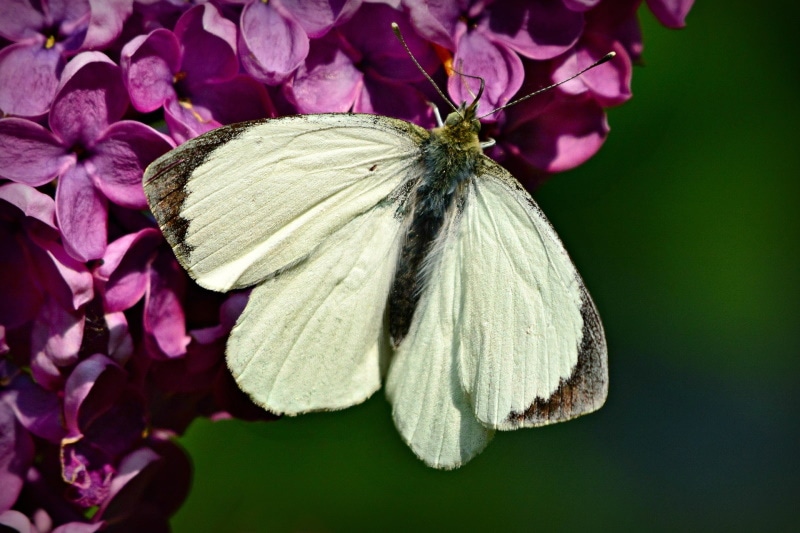
| Scientific name: | Pieris rapae |
| Size: | 1.25 to 1.8 inches |
| Primary colors: | White |
While many butterflies have dark colors with bright colors that contrast, that’s not the case with the cabbage white. They have gray and black flecks on their wings, but it’s their almost all-white appearance that makes this such a unique butterfly to spot.
8. American Snout

| Scientific name: | Libytheana carinenta |
| Size: | 1.25 to 2 inches |
| Primary colors: | Brown and orange |
The American snout butterfly is a butterfly that you can find in Tennessee that probably won’t make you turn your head. Not only are they on the smaller side of things, but they’re also not the most colorful.
They do have a few orange spots, but their most notable characteristic is their brown coloring. Still, they’re plentiful in Tennessee, and there’s a good chance that you can spot one if you keep a lookout for them.
9. Viceroy

| Scientific name: | Limenitis archippus |
| Size: | 2.5 to 3.75 inches |
| Primary colors: | Black and orange |
At first glance, a viceroy butterfly looks like a monarch. But a closer look reveals subtle differences. Not only is the viceroy butterfly smaller, but they also have black lines along the lower wings and no white dots on the body.
Still, to the untrained eye, there’s not much of a difference. You can find these butterflies throughout the entirety of the eastern and central United States.
10. Hackberry Emperor
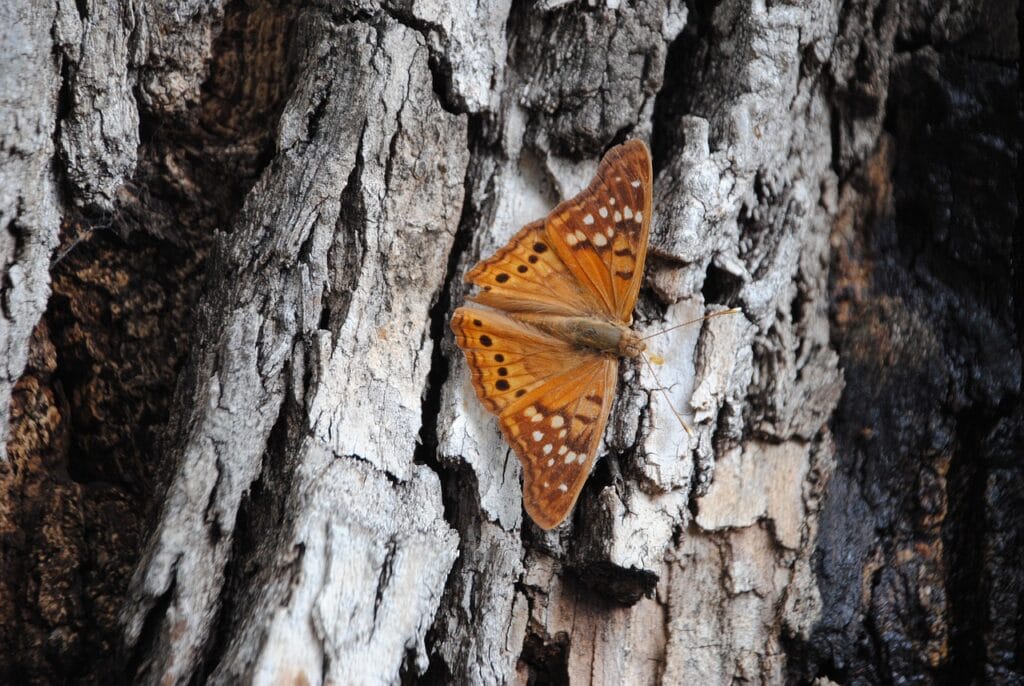
| Scientific name: | Asterocampa celtis |
| Size: | 2 to 2.8 inches |
| Primary colors: | Brown |
If you’re looking for the most colorful butterfly out there, the hackberry emperor isn’t it. But what makes the hackberry emperor such a unique butterfly to look at is their spots. They have plenty of eyespot marking throughout that really makes them pop.
Their actual body coloring is mostly brown, with flecks of black and white, but the markings will make you look twice at this butterfly.
11. Question Mark
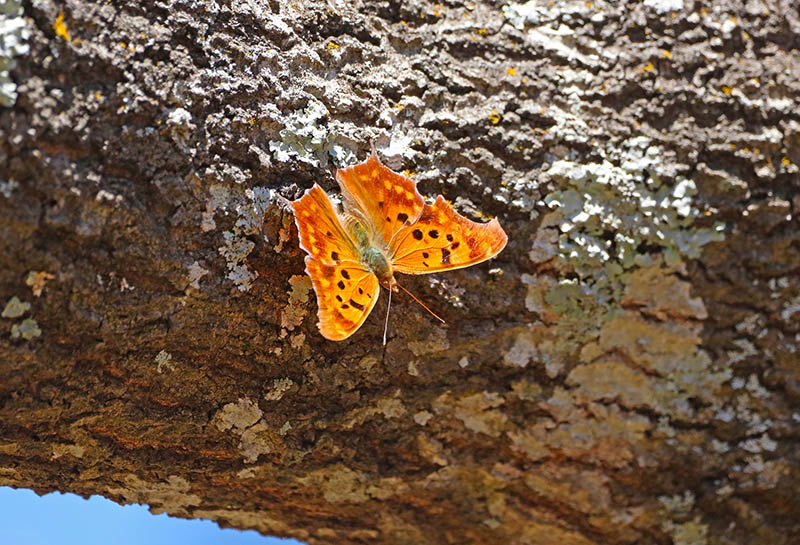
| Scientific name: | Polygonia interrogationis |
| Size: | 2 to 2.5 inches |
| Primary colors: | Orange and black |
While the question mark butterfly gets its name from the shape of its wings, you’re not likely to notice unless it’s standing still. It’s a subtle look, though the orange coloring throughout the body is anything but subtle.
They live throughout the entirety of the eastern and central United States, and you can find them in any part of Tennessee.
12. Red-Spotted Purple
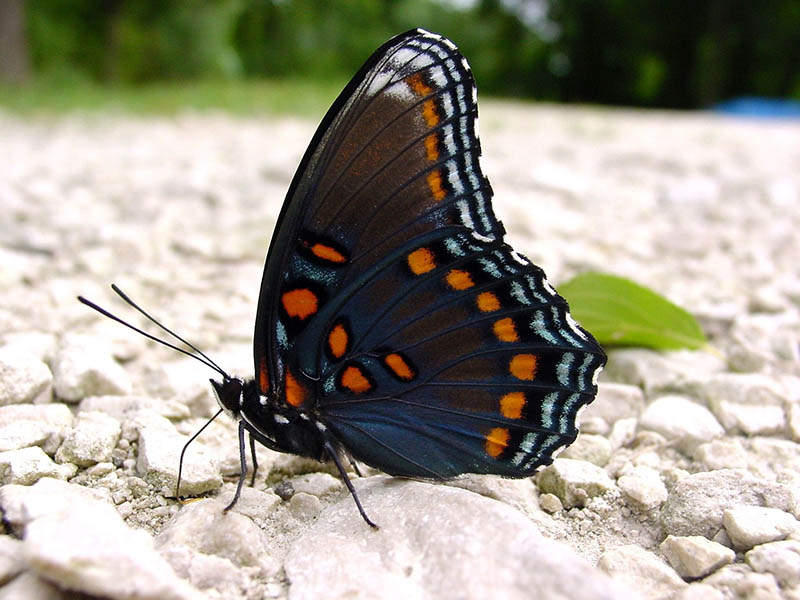
| Scientific name: | Limenitis arthermis |
| Size: | 3 to 3.5 inches |
| Primary colors: | Blue and black |
While most of the butterflies on this list have orange or brown colors, that’s not the case with the red-spotted purple butterfly. Instead of a brown, black, or orange base, it’s blue. The exact hue depends on the specific butterfly you’re looking at, and it can range from light blue to dark purple.
You can also see white and orange spots, but it’s the blue coloring that really makes this butterfly stand out from the rest.
13. Common Wood Nymph
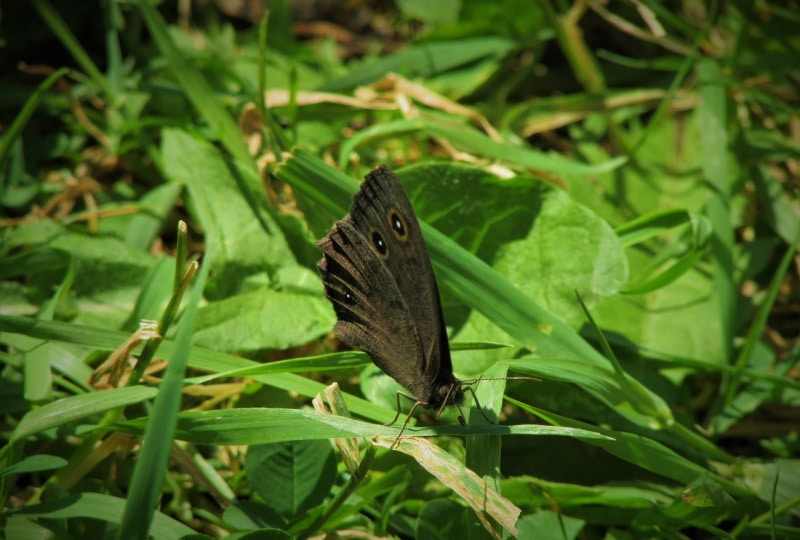
| Scientific name: | Cercyonis pegala |
| Size: | 1.75 to 3 inches |
| Primary colors: | Brown |
Between the small size of the common wood nymph and their brown coloring, this isn’t the most impressive-looking butterfly on this list. Still, they’re abundant throughout Tennessee, and they have unique eyelet spots on their wings.
They’re mostly brown with a small patch of yellow, and this coloring helps them blend into their surroundings. If you happen to spot one, take a few seconds to look at it, and you should start to appreciate it a bit more than you did at first glance.
14. Pearl Crescent

| Scientific name: | Phyciodes tharos |
| Size: | 1.25 to 1.75 inches |
| Primary colors: | Orange and brown |
The pearl crescent is a small butterfly, but it has beautiful colors. They’re orange and brown, with a brown fringe around the outer portion of their wings. They thrive in wet and moist conditions, so this is where it’s easiest to spot them.
You can typically find these butterflies in open fields, but they will occasionally venture into other environments if they need to.
15. Goatweed Leafwing

| Scientific name: | Anaea andria |
| Size: | 1.75 to 2.5 inches |
| Primary colors: | Orange and brown |
The goatweed leafwing has the most interesting name of all the butterflies on this list, and they look a bit different too. They have large wings that overlap, so when you view them from the top, it looks like they only have one wing on each side.
The inside is a bright orange color, but when they fold their wings up, they look just like a brown leaf. You can find the goatweed leafwing throughout Tennessee, though they’re most abundant on the state’s western side.
16. Eastern Comma
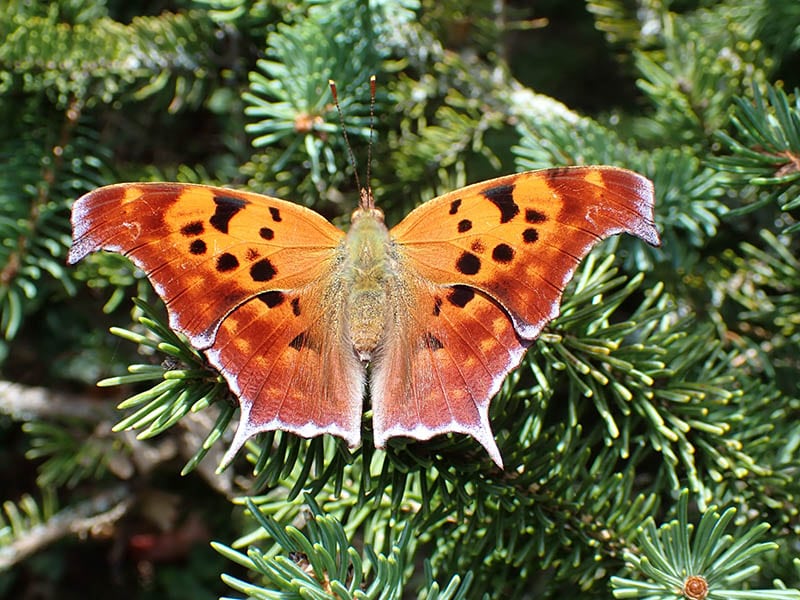
| Scientific name: | Polygonia comma |
| Size: | 1.8 to 2.5 inches |
| Primary colors: | Orange and brown |
If you live in suburban Tennessee, the eastern comma is one of the most common butterflies that you’ll find in your yard. They thrive in forests, yards, and parks. The outer portions of their wings are a bit jagged in appearance, but this helps them blend into different environments.
The inside of their wings is bright orange with black spots, and you can see a white coloring outlining their wings.
17. Appalachian Brown
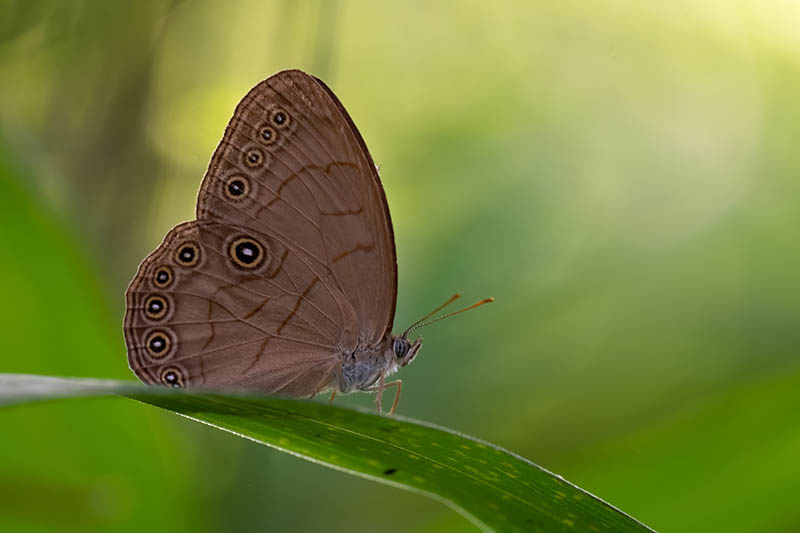
| Scientific name: | Satyrodes appalachia |
| Size: | 1.75 to 2.25 inches |
| Primary colors: | White and brown |
If you’re looking for a butterfly with the most unique markings, the Appalachian brown would be near the top of the list. This all-brown butterfly has plenty of eyelet markings that makes them worth a second or third look.
They average about 2 inches in wingspan, which puts them on the smaller side of things. They’re most prevalent throughout the eastern side of Tennessee, along the Appalachian Mountains, but it is possible to see them in other parts of the state.
18. Common Buckeye

| Scientific name: | Junonia coenia |
| Size: | 1.5 to 2.75 inches |
| Primary colors: | Brown and orange |
The common buckeye loves wide open spaces. You can find them in fields, pastures, and even near roadways, where there’s plenty of space for them. One unique thing about the common buckeye is that you can spot them year-round.
They have a few unique colored eyelet markings when they open their wings, but otherwise, they’re a subdued brown color.
19. Variegated Fritillary
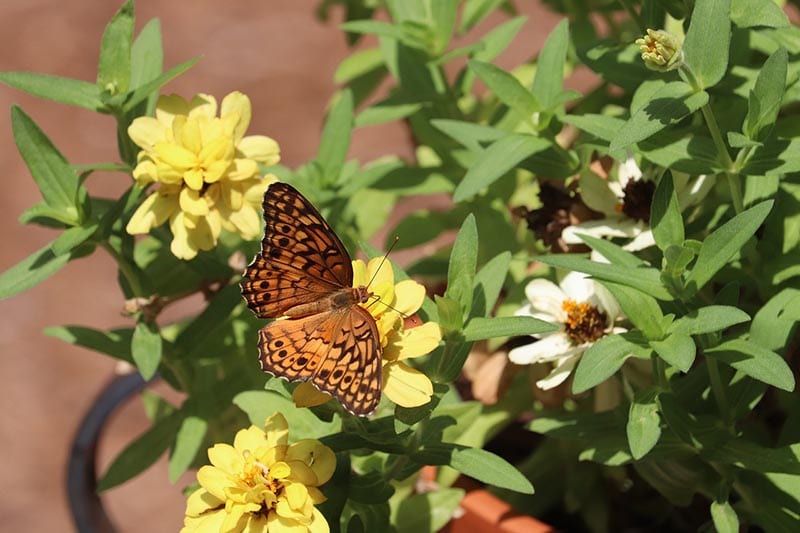
| Scientific name: | Euptoieta claudia |
| Size: | 1.75 to 2.25 inches |
| Primary colors: | Orange and black |
The variegated fritillary is an orange and black butterfly that you can find in Tennessee. They’re small, with an average wingspan of around 2 inches. You can find them throughout all of Tennessee. Interestingly, the caterpillars are orange and black, with protruding black spikes that help protect them.
20. Little Wood Satyr
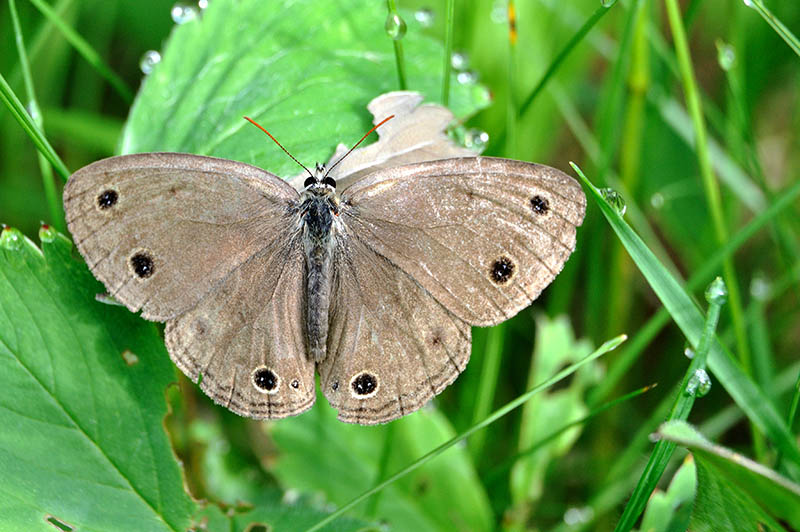
| Scientific name: | Megisto cymela |
| Size: | 1.25 to 1.75 inches |
| Primary colors: | White and brown |
The little wood satyr is one of the smallest butterflies on this list, with the tiniest members only reaching a wingspan of 1.25 inches. They also don’t have the most striking appearance.
They’re white, but it’s a “dirty” white, with plenty of brown patches throughout. They have a few eyelet markings, but these are not as distinct as those of many other butterfly species.

Conclusion
With so many butterfly species in Tennessee, there are plenty for you to see. They’re all over the place, from open fields to woodlands, so you can find butterflies just about anywhere.
So, the next time that you’re out, look for any of these beautiful butterflies, and you should be able to spot quite a few in Tennessee.
Featured Image Credit: Bill Barlow, Pixabay
Contents

